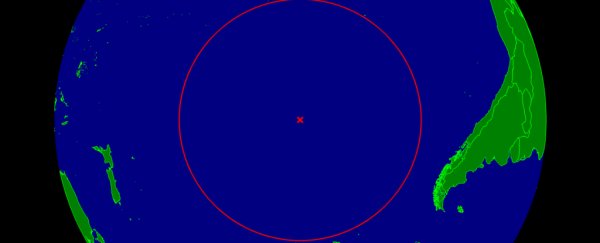The International Space Station (ISS) has been in orbit since 1998, and is scheduled to come out of service in 2024, after 26 years of active satellite duty. So what happens then?
Leaving the ISS to simply run out of fuel and fall where it may isn't exactly a safe option, which is why NASA has identified a deep, remote part of the ocean to submerge the station. This so-called Spacecraft Cemetery has actually been the final resting place of many a human-made space vehicle through the years.
As Shannon Stirone reports for Popular Science, the sector of the Pacific Ocean earmarked by NASA is located 3,000 miles (4,828 km) off the eastern coast of New Zealand and 2,000 miles (3,218 km) north of Antarctica. It's one of the most remote spots on the globe, and is about 2.5 miles (4 km) deep.
It has a technical name too: the Oceanic Pole of Inaccessibility. That means it's the point in our oceans furthest from any landmass, which is why it's the preferred choice of space agencies eager to avoid crashing their spacecraft into any populated areas.
The Oceanic Pole of Inaccessibility has welcomed several hundred decommissioned spacecraft since 1971, from Europe, Russia, Japan, and the US. The MIR station, in operation from 1986 to 2001, is another notable space station that currently rests under the ocean in this spot.
At around 450 tonnes in weight, the ISS is about three times larger than MIR, which means some incredibly detailed calculations are going to be required to make sure it reaches its target in 2024 – not least because it's going to break up into multiple pieces as it re-enters Earth's atmosphere.
Sonic booms and fiery streaks in the sky marked MIR's descent 15 years ago, and the demise of the even larger ISS should look considerably more spectacular for anyone watching the sky at the right moment.
At this point, though, no one's sure exactly when that moment will be – the ISS is scheduled to stay in service until 2024 at least, but studies are being carried out to see if this time period could be extended to 2028, which means the station could rack up an impressive 30 years in orbit.
Once the end is nigh, there are plans to reuse parts of the ISS in another internationally managed space station led by the US and Russia – but much will depend on the administrations running the two nations in the next decade, and ultimately how well they get along.
When the time comes, a targeted burn of fuel will direct the ISS into Earth's orbit. Once it's broken up in the atmosphere, the debris could cover an area 400 miles (643 km) long and 30 miles (48 km) wide. By the time the fragments reach the height of a passenger jet, they'll be falling straight down, like a piano coming out of a window.
At that stage, the replacement for ISS should be up and running.
In the meantime, if you're planning to go hunting for space station fragments out in the remotest part of the ocean, pick your foraging window wisely – and make sure to look out for sea monsters.
